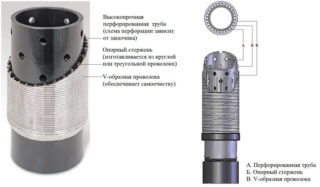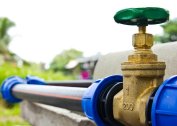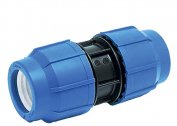Pure drinking water is the key to excellent health and good health. Therefore, due attention should be paid to the post-treatment of the liquid supplied from autonomous sources of the suburban area or in the country. Full-fledged filtration of water from the well allows it to be consumed without problems, used for household appliances, heating equipment. It is necessary to install a treatment system at the bottom of the source and after entering the main into the house.
Purpose of filters

Any treatment plant is divided into two types - coarse and thin. The first ones are designed to prevent large suspensions such as sand, clay, pebbles of gravel, etc. from entering the water. Impurities do not enter the well string, do not silt its bottom. Thin filters are designed for post-treatment of liquids from dissolved chemical elements:
- salts of calcium, magnesium;
- ferrous iron;
- manganese;
- nitrates;
- petroleum products;
- organics and bacteria;
- hydrogen sulfide, etc.
Properly selected coarse filters for water from the well are the key to the full operation of the hydraulic structure. Otherwise, the source will often have to be pumped.
Types of Coarse Filters
In total, several types of treatment devices for rough cleaning are distinguished.
Reticulate
A stainless steel wire is used, from which a fine-mesh wire is made. Such filters are used for sand wells. The mesh size is 0.12-3 mm. Sand will not pass through it.
Of the advantages of such devices are:
- ease of installation;
- good cleaning ability.
The minuses include:
- quick clogging of mesh cells with grains of sand;
- equipment failure due to clogging;
- bringing the source to a decrease in productivity due to the high resistance of the grid.
This type of filter for water wells is especially quickly clogged with particles of iron and lime. Therefore, such devices are not placed on highly mineralized or Fe-enriched water. Such a filter is well suited for an Abyssinian needle well.
Slotted hole filter
Devices are a perforated segment of the casing in its lower part. Slots or small holes are made at a distance of 1.5 cm from each other around the entire circumference of the tube and over 1 m from its lower point. A slit or hole filter is used on an artesian well for water enriched with lime, but not clay or sand.
It is most convenient to apply perforation on granite or crushed stone horizons or where there is a threat of collapse, destruction of rocks.
The cost of the slit filter varies depending on the material of its manufacture, the number of holes per 1 cm2 and their parameters (sizes).
Coarse wire
These types of installations can be equally effectively used both for a well on sand and for an artesian source. The main components of the wire filter are the frame, perforated base and sump. Externally, such a device looks like a piece of pipe with perforations of 10-20 mm in size, covered with wire winding.
The main advantages of the device:
- durability;
- good cleansing ability;
- the ability to replace the filter under the condition of two pipes of the column - the main and operational. If both functions are performed by one tube, it is impossible to dismantle the wire structure and install a new one.
The main disadvantage of a wire filter is the difficulty of cleaning it.
Gravel backfill
As a treatment system, the casing is sprinkled with a layer of sand and gravel. The particle size of the pebble is 5-10 times larger than the fraction of the main rock of the aquifer. As a rule, the thickness of the backfill layer reaches 15-20 cm.
The main advantages of the gravel filter are safety and full environmental friendliness.
Varieties of sewage treatment plants for the home
The second stage of well water post-treatment is fine filtering - removal of any external dissolved impurities from the liquid. To do this, use a variety of settings, depending on the results of laboratory analysis of the borehole resource.
Iron removers
Iron in a concentration above normal causes irreparable harm to human health, so it is important to remove the chemical element from the water. To do this, use:
- Pressure aerators. They are columns into which air is supplied under pressure. Combining with iron molecules, oxygen leads to their oxidation. The chemical element goes into a trivalent suspended state. It remains only to remove visible particles of iron using a mechanical filter.
- Pressure-free installations for deferrization. Water from the well is fed into large tanks through nozzles. When it is sprayed, the dissolved iron comes in contact with oxygen. In the process of oxidation, Fe goes into a trivalent state and is removed from the liquid through a strainer.
- Coal filling. Only work if there is Fe3 in the water. It is important to regularly change the cartridges.
- Ion exchange installations. Iron ions are replaced by sodium ions. Ion exchange resin also requires regular replacement. In addition, it cannot be disposed of with household waste.
Aerators are best suited for homes.
Reverse Osmosis Systems
These are multistage purification systems, thanks to which water can be completely filtered out from nitrates, iron, chlorine, pesticides, lime and other impurities. The installation works on the principle of running water through a membrane under high pressure. Such a barrier allows only liquid molecules to pass through, but not particles of impurities. All dirt is then washed off the membrane and discharged into the sewer. Self-cleaning occurs.
After the water passes through the membrane, it is sent to the flasks with coal beds or mineralizing layers to completely purify and enrich with the necessary trace elements.
Reverse osmosis is connected under a sink with a separate tap for drinking water. The filter membrane and its other fillings need to be changed regularly.
Main flow units
These are the most powerful types of filters that put on the input of the water supply line into the house. The main equipment has a good degree of purification and also drives the liquid through several flasks - mesh, with filtration coal, ion exchange. The main equipment can be placed on hot and cold water.
Budget option - standard jug
If the laboratory analysis showed small amounts of foreign impurities in the water, you can just buy a filter jug with a replaceable cartridge. It is selected according to the type of liquid contamination - for iron, chlorine, lime, etc. The most popular jug among Russians is Aquaphor. The same manufacturer offers the buyer more complex reverse osmosis systems.
How to determine the type of coarse filter
Bottom treatment facilities are selected according to the type of horizon impurities and their fractions. Recommendations:
- For artesian springs in rocky horizons - rod or tubular filter slotted or with round perforation.It prevents particles of rubble and gravel from entering the shaft with a fraction of 20-100 mm.
- Wells with a gravel bottom or a base of gravel sand - perforated filter with stainless steel wire wrap. Stops the penetration of particles 1-10 mm in size.
- The sandy bottom with a size fraction of impurities of 1-2 mm is a slotted or perforated filter with a wire winding or a square mesh.
- Single, double layer gravel filter stops the penetration of 0.25-0.5 mm impurities into the well shaft.
Before selecting the type of treatment system, it is important to accurately determine the type of aquifer and the rocks prevailing in it.
How to install a coarse filter
Any home-made sewage treatment plant (slotted, perforated section) is prepared on the surface with their own hands before the start of casing. To do this, holes are formed on a polypropylene pipe using a puncher or a gas cutter. The scheme of their location - lines or staggered. The indentation step is 1.5-2 cm. All openings must be made by stepping back from the bottom edge of the column 100 cm. The bottom of the pipe must be closed with a wooden cork or welded.
The finished perforation is wrapped with a mesh. The cell size is selected experimentally. They try to spill water with sand admixtures of different fractions through the net. Well, if the cells do not pass more than 50% of the granules.
The grid is fixed with rivets or spot welding.
When ready, the pipe with the bottom filter is lowered to the bottom of the source, expanding the column in whole segments.
When installing a gravel filter, there is one condition - the diameter of the source must be larger than the casing cross section. In other cases, you can not even start the device of gravel layers. After the lower perforated part of the barrel is lowered into the well, it is sprinkled with coarse and medium fraction gravel. Layer thickness - over the entire perforation height.
The cost of filters for water wells
Prices for filters for water purification from a well to a private house vary depending on the type of installation:
- the cheapest plastic jug Aquaphor - from 280 rubles. and higher;
- installation for the Akvaklin coffee machine (for hard water from a scum) - from 1,500 rubles .;
- reverse osmosis for liquids on drink - from 7,100 rubles;
- aeration column - from 33 000 rubles .;
- ion-exchange plants - from 2,500 rubles .;
- main washing - from 920 rubles;
- plastic (NPVH) with LDPE spraying - from 4,900 rubles .;
- downhole slotted frame filter FSSC - from 4,500 rubles .;
- frameless - from 3 000 rubles.
The total cost of any type of system for cleaning fluid from a well / well needs to add the cost of buying replacement cartridges. Most consumers in Russia prefer to purchase treatment facilities in Leroy Merlin. Reviews about this market are the most worthy.












